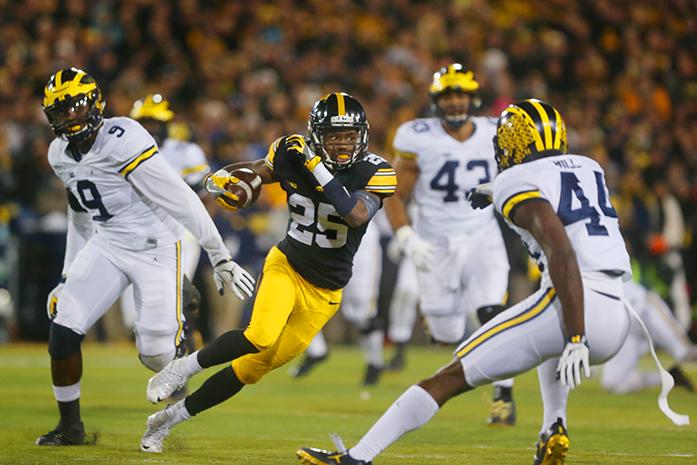By Blake Dowson
It took almost a perfect game for Iowa to beat No. 2 Michigan on Nov. 12 in Kinnick. Going into the contest, the Hawkeyes knew it would have to be a low-scoring affair and they needed to win the turnover battle, or at least come out even in that category.
They got both those things accomplished, and the Hawkeyes came away with their first win against an AP top-2 team since 1985.
Here’s how Iowa got it done.
Akrum Wadley — 167 yards from scrimmage
Wadley carried the Iowa offense throughout the game. Fellow running back LeShun Daniels Jr. had a drive or two where he ran over a couple would-be defenders, but it was mostly Wadley.
And saying it was mostly Wadley is to undersell just how historically significant his performance was. He has had games in which he rushed for more yards, but none bigger than Nov. 12.
Wadley’s 167 yards from scrimmage were slightly more than 72 percent of Iowa’s 230 total yards from scrimmage. Since 1996, no other player in college football has contributed a bigger percentage of his team’s total offense in a win against an AP top-2 team.
Call it an obscure statistic if you will, but it is impressive nonetheless. When you consider other names on the list (LeSean McCoy vs. West Virginia in 2007, Warrick Dunn vs. Florida in 1996, Darren Sproles vs. Oklahoma in 2003, Jacquizz Rodgers vs. USC in 2008) it’s fairly eye-opening.
Michigan — 201 yards of total offense
The Wolverines struggled all night to move the ball against an Iowa defense that pulled a complete 180 from its performance against Penn State on Nov. 5. In that game, the Hawkeye defense gave up the most yards in the Ferentz era.
Michigan, which came into the Iowa contest averaging 497 yards per game, managed less than half of that against the Hawkeyes.
Not coincidentally, the Wolverines struggled to put points on the board without much offensive production. Through nine games, Michigan was averaging 48 points per game, but scored only 13 against Iowa — its lowest total of the season.
The strong defensive effort by the Hawkeyes was seen through both the running and passing game effort. Michigan came in averaging 251 yards rushing and 245 yards passing. It gained 98 yards on the ground against Iowa and 103 through the air. The balance in its offense stayed the same, but production was less than half of the norm.
Jabrill Peppers — 2 returns for 35 yards
Peppers, the hybrid defensive back/linebacker/h-back/return man, is possibly the most explosive playmaker in the entire country.
He averages 17 yards per punt return, easily the best in the Big Ten. He also averages 25 yards per kick return.
The Hawkeyes were able to limit his touches in the return game. He returned only one punt (though it was for 19 yards) and one kick, for 16 yards.
Iowa punter and kickoff specialist Ron Coluzzi made it a point to stay away from Peppers, pooch kicking a few kickoffs and sending a rugby punt downfield at one point.
The more Peppers touches the ball, the better the chance Michigan breaks a big play. Iowa did an outstanding job of keeping the ball away from him, and got lucky in that the Wolverines didn’t involve him all that much in the offense.



